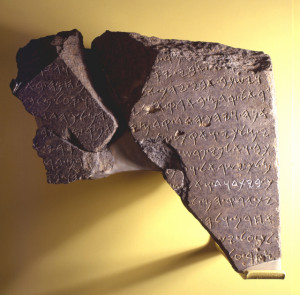How I Discovered the “House of David” Inscription, Gila Cook, COJS.
On July 21, 1993 Avraham Biran, the director of the Tel Dan excavations and the Nelson Glueck School of Biblical Archaeology drove up to Dan to meet the supervisor of the Israel Antiquities Authority reconstruction crew working at the site. Biran suggested that I go up to Dan with him to finish taking measurements in Area AB on the crest of the ramparts. When we arrived, I trudged up the tel loaded down with all my equipment and began work. At around 2 PM, in the heat of the midday son, Biran hollered up to me to tell me that he was ready to go; I continued working because I needed to finish what I started. A few minutes later Biran yelled out again in his booming voice, “Come down already!”—he was impatient to hit the road and was irritated that I was holding things up. Finally I finished and came down the ancient stone road, through the Iron Age gates and plopped down my bag, drawing boards and measuring rod next to a wall in Area A at the eastern edge of the ancient piazza. I bent down to lean the optical level machine and tripod down against a basalt stone at what seemed to be the southern end of a wall. Something on the exposed tip of the next still-buried stone caught my eye, but I looked away for a moment as I began to dismantle the level from the tripod. In this brief interval, my mind registered what I had seen. I looked again and said to myself, “Oh! These are Hebrew or Phoenician letters! It’s an inscription…with rows of characters”.
At this point, Biran’s booming voice called out again “nuuu… (a Hebrew exclamation of impatience)! I turned toward him and thought to myself “How do I say in proper Hebrew, “I’m going to make your day”. I walked right up to him, looked him in the eye and all that would come out of my mouth was, “come!” Biran looked at me as if I was crazy (people usually didn’t talk to him that way). Once again, I said, “come”, turned away from him and walked back toward the stone. He didn’t say anything, but I knew he was following me. I stopped at the stone, pointed at it and said, “Here!” Due to the angle of the sun Biran couldn’t see what I was pointing at, so I said, “bend down closer”. He got down on his knee, but didn’t immediately see what I was on about. He looked up at me blankly, but then I could see something register on his face. He looked back at the stone, back at me, then back at the stone again, and said, not in Hebrew, but in impeccable English, very quietly, “Oh my God!”
I set up my measuring instrument, Biran held the measuring rod and we took elevations of the inscription and its surrounding stones. I then drew them into the existing plan of Area A. Biran photographed the stone from all angles and then brought a blanket and excavating tools from the trunk of his car. We proceeded to excavate around the stone; there was no question of leaving it in the field. We removed the stone from the wall and photographed it again from all angles. After checking the area for more possible pieces, we placed the stone on the blanket and carried it to the car.
On the way back to Jerusalem we stopped off at Kibbutz Ashdot Yaakov to meet Yitzhak Kafhi, the copyeditor of Biran’s then forthcoming Hebrew book, Dan – 25 Years of Excavation at Tel Dan. Biran wanted to show the inscription to Yitzhak. We also rang up Yigal Ben-Ephraim who was the archaeologist supervising the restoration work being carried out by the Israel Antiquities Authority, and notified him of the discovery (and why there was a big hole in the ground at the south end of the still-embedded wall).
Back in Jerusalem, early the next morning, Biran took the inscription to the home of Prof. Yosef Naveh, a specialist in ancient Semitic epigraphy. Biran and Naveh later published the inscription together in the Israel Exploration Journal.
The discovery of the inscription was one of the highlights of my life and I am glad that the lighting was right, the angle was right and that I have pretty sharp eyesight. I am pleased that I recognized what I saw—it’s gratifying to know that this is one of the most significant finds in the archaeology of the ancient Near East.
Gila Cook
Architect for the Tel Dan excavations
Hebrew Union College – Jewish Institute of Religion, Jerusalem
See also-





10 Comments on "How I Discovered the “House of David” Inscription, Gila Cook, COJS."
Trackback | Comments RSS Feed
Inbound Links